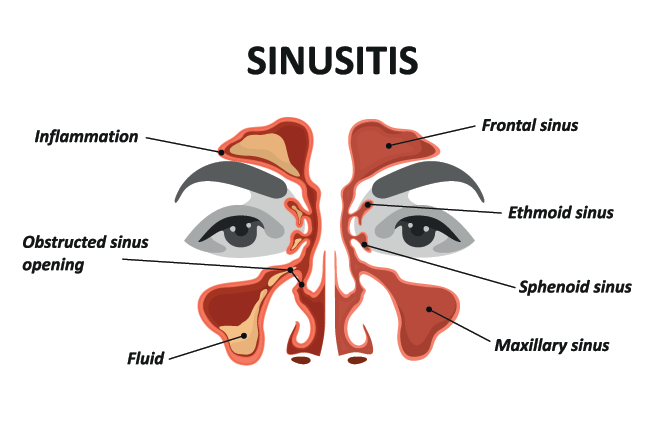How sinuses affect the eyes, and what you can do about it

Can a sinus infection affect your eyes?
A sinus infection (sinusitis) can cause pain around your eyes, eyelid swelling and other symptoms that can affect your vision. Get eye pain and vision changes checked out by an eye doctor as soon as possible to avoid vision loss and other eye health issues.
What is sinusitis?
Sinusitis is an inflammation or infection of the sinuses, which are hollow spaces near your eyes and nose. The sinuses make mucus, which drains out through your nose. Typically filled with air, sinuses that are blocked fill with fluid. This extra fluid promotes germ growth and the potential development of a viral, bacterial or fungal infection.
The maxillary sinuses (below your eyes) are most likely to get infected. A maxillary sinus infection may cause pain below the eyes and in the cheeks. You also have sinuses:

Between your eyes (ethmoidal)
Behind your eyes (sphenoidal)
Above your eyes (frontal)
Infected sinuses may cause you to experience the following symptoms:
Headache
Congested or runny nose
Facial pain
Cough
Fever
Sinus pressure
Sore throat
Bad breath
A sinus infection may clear up in less than a month with treatment. However, some patients may develop chronic or recurring infections.
Eye symptoms
In addition to eye pain or pain behind the eyes, there are other eye symptoms that may be caused by infection-related sinus pressure. These may include:
Eye pain – You may feel pain behind or around the eyes. This may feel like pain in your eyes or a headache behind your eyes.
Eye watering – A chronic infection can lead to watery eyes (epiphora). But these symptoms may also be caused by other conditions. A cold or allergies may cause eye watering and a feeling of stuffiness or pressure. A cluster headache can similarly cause pressure, watery eyes and a stuffy nose.
Swollen eyes – You may also experience eyelid swelling and eye puffiness. This can occur when the sinuses between and below your eyes become inflamed and clogged with mucus. The swelling typically goes away as your condition improves with treatment.
Sinus problems such as chronic sinusitis can also cause blurry vision, vision loss and other problems due to optic nerve damage caused by chronic inflammation, although this is rare.
SEE RELATED: Pressure behind the eye
Can you get a sinus infection in your eyes?
In some cases, a sinus infection can spread to the eyelid, skin and soft tissues.
Periorbital cellulitis, also known as preseptal cellulitis, can occur when the area around the eye, including the eyelid, becomes infected.
Orbital cellulitis can occur if the eyeball itself, and the tissues around the eyeball, become infected. Periorbital cellulitis cannot develop into orbital cellulitis because a fibrous tissue surrounding the eyeball serves as a barrier.
Both of these conditions are more common in children than in adults. Periorbital cellulitis is more common and less dangerous than orbital cellulitis. Both conditions can cause red, swollen and painful eyelids. Fever may sometimes occur with periorbital cellulitis, although it is more common in orbital cellulitis. It is important to note that periorbital cellulitis does not typically affect vision or eye movement.
In addition to the symptoms above, symptoms of orbital cellulitis may include:
Fever
Malaise (general sense of being sick or uncomfortable)
Headache
A bulging eye (exophthalmos)
Eye pain, especially when moving the affected eye
You may be able to treat periorbital cellulitis at home with oral medications under close supervision of an ophthalmologist. Orbital cellulitis requires hospitalization and IV antibiotics. It is important to see a doctor right away if you think you or your child may have either condition.
Other sinusitis complications that can affect the eyes
There are other complications of infected sinuses that can affect your vision, though most are rare. It’s still a good idea to know about these problems so you can get medical care right away if necessary.
Cavernous sinus thrombosis
Cavernous sinus thrombosis (CST) is a rare but dangerous condition. It usually starts in one eye and spreads to the other. The most common symptoms are fever and headache, which may appear along with eye issues.
Several eye-important arteries and nerves pass through the cavernous sinus, so damage to this area can result in a number of eye complications.
Symptoms of CST may include:
Pain around the eye
Swelling of the eyelids
Drooping eyelids (ptosis)
Double vision (diplopia)
Light sensitivity (photophobia)
Vision loss
Less common symptoms may include confusion, face numbness, a stiff neck or coma.
It’s crucial to seek treatment right away because CST can be life-threatening and may cause blindness in up to 15% of cases. Treatment for CST typically requires antibiotics, antifungal medication and medicine to help prevent blood clots.
Bacterial meningitis
Bacterial meningitis is a rare complication and a medical emergency. The most common symptoms of meningitis include sudden headache with fever and a stiff neck.
Meningitis symptoms may also include:
Confusion
Sensitivity to light (photophobia)
Nausea
Vomiting
It’s important to see a doctor right away if you suspect meningitis because the condition can be life-threatening. Prompt treatment with antibiotics is key to recovery.
When to seek emergency medical care
If you’ve been diagnosed with or suspect sinus issues that may be affecting your eyes, you may need to see a doctor right away.
Seek emergency medical care if you have:
High fever
Stiffness of the neck
Breathing difficulty
Confusion
Blurry vision or other vision changes
Eye swelling and pressure
Severe pain in or around the eyes
Swelling around one or both eyes
If in doubt about your symptoms, it’s best to seek emergency care right away to protect your overall health as well as your eye health and vision.
Eye pain. MedlinePlus. April 2022.
Sinusitis. Johns Hopkins Medicine. Accessed April 2022.
Sinus infection (sinusitis). Cleveland Clinic. June 2020.
Pain in the quiet (not red) eye. American Family Physician. July 2010.
An association between acquired epiphora and the signs and symptoms of chronic rhinosinusitis: a prospective case-control study. American Journal of Rhinology. March – April 2003.
Cluster headache. MedlinePlus. Accessed April 2022.
What’s causing eyelid swelling after my sinus infection? American Academy of Ophthalmology. September 2018.
What to do about sinusitis. Harvard Health. January 2020.
Optic nerve changes in chronic sinusitis patients: correlation with disease severity and relevant sinus location. PLOS One. July 2018.
Preseptal and orbital cellulitis. MSD Manual Professional Version. August 2021.
Cavernous sinus thrombosis. StatPearls. November 2021.
Intracranial suppurative complications of sinusitis. Scandinavian Journal of Surgery. February 2016.
Bacterial meningitis. Centers for Disease Control and Prevention. July 2021.
Page published on Friday, June 3, 2022
Medically reviewed on Tuesday, April 12, 2022






